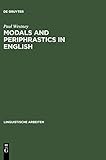Modals and Periphrastics in English : An Investigation into the Semantic Correspondence between Certain English Modal Verbs and Their Periphrastic Equivalents / Paul Westney.
Material type: TextSeries: Linguistische Arbeiten ; 339Publisher: Tübingen : Max Niemeyer Verlag, [2013]Copyright date: ©1995Edition: Reprint 2012Description: 1 online resource (225 p.)Content type:
TextSeries: Linguistische Arbeiten ; 339Publisher: Tübingen : Max Niemeyer Verlag, [2013]Copyright date: ©1995Edition: Reprint 2012Description: 1 online resource (225 p.)Content type: - 9783484303393
- 9783110958904
- Anglais (Langue) -- Auxiliaires
- Anglais (Langue) -- Modalité
- Anglais (Langue) -- Périphrases
- Anglais (Langue) -- Auxiliaires
- Anglais (Langue) -- Modalité
- Anglais (Langue) -- Périphrases
- English language -- Modality
- English language -- Verb
- Inglés -- Modo
- Inglés -- Semántica
- LANGUAGE ARTS and DISCIPLINES -- Grammar and Punctuation
- LANGUAGE ARTS and DISCIPLINES -- Linguistics -- Syntax
- Englisch
- Modalverb
- Periphrase
- LANGUAGE ARTS & DISCIPLINES / Linguistics / General
- 425 23
- PE1315.M6
- online - DeGruyter
- Issued also in print.
| Item type | Current library | Call number | URL | Status | Notes | Barcode | |
|---|---|---|---|---|---|---|---|
 eBook
eBook
|
Biblioteca "Angelicum" Pont. Univ. S.Tommaso d'Aquino Nuvola online | online - DeGruyter (Browse shelf(Opens below)) | Online access | Not for loan (Accesso limitato) | Accesso per gli utenti autorizzati / Access for authorized users | (dgr)9783110958904 |
Frontmatter -- Contents -- 1. Introduction -- 2. Periphrastic forms -- 3. Approaches to this area -- 4. Must, have (got) to, need (to) and be bound to -- 5. Other modal-periphrastic sets -- 6. Conclusions -- Bibliography
restricted access online access with authorization star
http://purl.org/coar/access_right/c_16ec
English has a number of periphrastic verbal forms that are semantically close to particular modal verbs and perform suppletive functions in relation to them (eg, have (got) to - must and be able to - can). After an exploration of the syntactic, semantic and phonological properties of potential periphrastic forms, this study investigates the nature of the relationship between the modals must, should, will and can and various semantically close periphrastics, using a spoken corpus of British English as the primary source of data. The focus is on the pragmatic interpretation of the items being compared, with some attention to their functions in discourse. These items are notoriously idiosyncratic both syntactically and semantically, but the general contrast claimed by some scholars between the maximally unmarked status of modals and the relatively marked status of periphrastics is amply confirmed, and this, together with the basic association of modality with alternative possible worlds, is shown to be reflected in a number of different ways, including the claimed 'objectivity' of periphrastics and the tendency of some to be associated with actuality. Level of formality is also found to be a significant, though not uniform, factor here.
English has several periphrastic verbal forms that are semantically close to particular modal verbs and perform suppletive functions in relation to them. After an exploration of the properties of potential periphrastic forms, this study investigates the nature of the relationship between the modals must, should, will and can and various semantically close periphrastics. The focus is on the pragmatic interpretation of the items compared, with some attention to their functions in discourse. Despite the relative idiosyncracy of all these items, the general marked status of periphrastics is evident, and this is shown to be reflected in a number of different ways. Level of formality is a further differentiating factor here.
Issued also in print.
Mode of access: Internet via World Wide Web.
In English.
Description based on online resource; title from PDF title page (publisher's Web site, viewed 28. Feb 2023)


